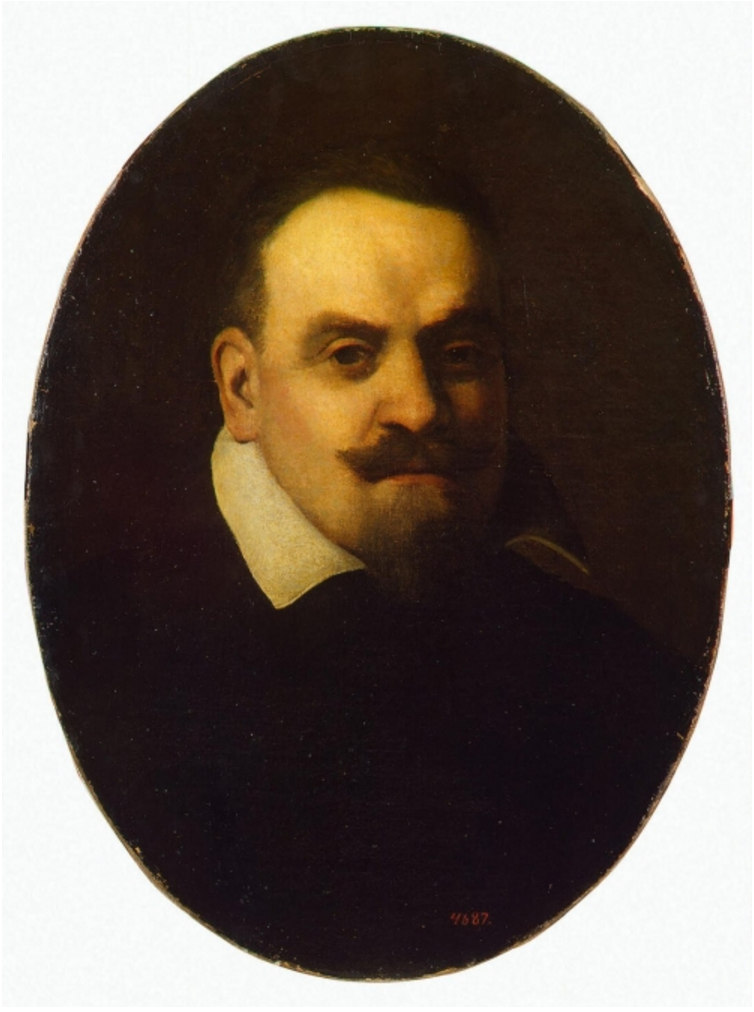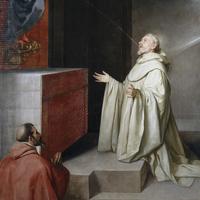More about Alonso Cano
Works by Alonso Cano

Contributor
You may know Alonzo Cano for his delicate religious portraiture, extensive array of sculptures, and disconcerting depictions of breast milk.
But do you know the talented Spanish painter for his explosive temper and open bigotry?
Cano had no shortage of aid on his path to artistic success. He studied with Velázquez under Francisco Pacheco, learned to paint under Juan del Castillo, Murillo’s instructor, and was schooled in architecture and sculpture. His slew of royal supporters ensured him unending fame and fortune. Yet despite the trappings of 17th century stardom, the “Spanish Michelangelo” stayed true to his character: that of a raging anti-semite with a penchant for brawling.
Cano’s most benign run-in with the law followed an infamously destructive temper tantrum. Enraged by a patron who criticized a statue’s weighty price-tag, Cano smashed the offending artwork to smithereens. Unfortunately, the piece in question was a depiction of a saint, making his violent display a sacrilegious offense punishable by death.
Cano learned little from this close call. In 1638, he fled Sevilla after a dicey duel with fellow artist Sebastián de Llano y Valdés. Six years later, Cano again became a fugitive when his wife was mysteriously stabbed to death in the couple’s Madrid home. Circumstances indicated a certain nefarious servant’s involvement: the house was robbed and the suspect in question had taken flight. Despite evidence to exonerate him, Alonzo’s fiery temper landed him in hot water. He retreated east to Valencia a wanted man, reluctantly returning to Madrid to accept his fate. Cano’s trial consisted of a bout of torture. Owing to his innocence or murderous determination, Cano withstood the tribulation with alibi intact. King Philip IV took back the malevolent court painter with open arms.
Cano’s treachery didn’t end here, however. He was also a proud bigot, demanding that his bewildered servants bring him a change of clothes if he happened to brush by a Jew in the streets. On his deathbed, Cano purportedly refused a priest because he accepted Jewish converts. No matter how delicate his religious tableaus, Alonzo Cano’s dubious morality joins him to the ranks of artistic infamy alongside abusive pedophile Gauguin, sword-slinging Caravaggio, and gruesome murderer Benvenuto Cellini.
Sources
- “Alonso Cano.” Encyclopedia Britannica. November 29, 2004. Accessed December 30, 2017. https://www.britannica.com/biography/Alonso-Cano.
- “Alonso Cano (1601-1667).” Visual Arts Cork. Accessed December 30, 2017. http://www.visual-arts-cork.com/sculpture/alonso-cano.htm.
- “Alonzo Cano.” Wikipedia. December 3, 2017. Accessed December 30, 2017. https://en.wikipedia.org/wiki/Alonzo_Cano.
- Jones, Jonathan. “The 10 Most Criminal Artists Ever.” The Guardian. February 27, 2014. Accessed December 30, 2017. https://www.theguardian.com/artanddesign/jonathanjonesblog/2014/feb/27/….
- “Juan del Castillo.” Wikipedia. April 8, 2017. Accessed December 4, 2017. https://en.wikipedia.org/wiki/Juan_del_Castillo.
- Kugler, Franz, Margaret Hutton, and Edmund Head. Handbook of Painting. London: John Murray Albemarle Street, 1854.

Contributor
Alonso Cano had a taste for three things: artistry, anti-Semitism, and aggravated assault, and he wasn’t 100% committed to that first one.
The idea of the “sensitive artistic type” is so widely-accepted at this point that pretty much everybody tends to picture painters as shy, socially-awkward eccentrics who are long on talk and short on action. Hearing this, 17th-century painter/sculptor Alonso Cano would likely listen with quiet dignity and then bash the speaker across the face with one of his own statues while cursing them as a vulgar, ignorant peasant. Cano may have been known for his tender, passionate depictions of saints in the throes of religious ecstasy, but if anybody ever called him “sensitive” they meant it the same way you would when describing an AK-47.
The story of Alonso Cano’s life can essentially be summed up as follows: 1) Move somewhere 2) Become really big in the local art scene 3) Get mad for a dumb reason and wreck the holy living hell out of somebody 4) Flee in disgrace 5) Repeat. Starting out under the tutelage of his father in the Spanish city of Granada, Cano moved at 13 to Seville to study painting under Diego Velazquez and sculpture under Juan Martinez Montanes (known locally as “the God of Wood” for his sculpting prowess, so you know, no pressure or anything). None of Cano’s sculptures still exist from his time in Seville -- for those of you who’ve been out of the loop over the past 400 years there have been just a whole bunch of wars in and around Spain -- but thankfully some of his paintings managed to survive (true to his later form, a whole slew of them are of popular saints -- he kind of had a thing).
His time in Seville came to an end in 1637, when for the first time (but oh good Lord not the last) he got in entirely-his-fault trouble, having found himself in a duel with fellow painter Sebastian de Llanos Valdes. Cano, known for neither his restraint nor his unfamiliarity with handling a weapon, almost killed the poor guy. (Sadly, though many of Valdes’s paintings still survive, the fact that Cano almost disemboweled him seems to be the main reason anybody ever talks about him anymore).
From Seville Cano made his way to Madrid, where his artistic skill led to his eventual appointment as Master of the Royal Works and Painter to the King. All sorts of great artistic endeavors sprang out of Cano’s new position, including palaces, city gates and tributes to visiting monarchs, and he came to be known as the “Spanish Michelangelo” (either because of the beauty and craftsmanship of his work or, just as likely, because he had a habit of going after people with nunchucks.)
That all ended when Cano was kind-of-sort-of accused of maybe murdering his wife and he had to leave the city in a hurry. (Whether or not he actually did so is a matter of some question; Mrs. Cano’s murder coincided with the sudden disappearance of a rather shifty journeyman from their estate, and the royal case against Cano mostly consisted of “Hey, you’ve all seen how this guy gets.”) He laid low for a while but eventually returned to Madrid to show the King of Spain who had the right of things; this proved to be slightly premature, as he then had the ever-loving crap tortured out of him. Something in the way he kept quiet while hot pokers were shoved who-knows-where seems to have impressed His Majesty, however, and Cano actually found himself restored to royal favor pretty quickly. For whatever reason, Cano decided he didn’t want to spend a whole lot of time with the king after that and in 1650 he took his vows and went to live with the church in Granada.
The story might have ended there, with Cano quietly spending the rest of his days painting in the solitude of ecclesiastic life. This being Alonso Cano, what actually happened was that a few years later he got into an argument with a city official about how much a statue of a saint ought to cost, which led to him smashing the sculpture against the wall and telling the other man he didn’t know what the hell he was talking about. Both church and state frowned pretty severely on desecrating saintly forms -- the penalty for such acts was usually death -- but the Spanish authorities seem to have figured out that this was just how Alonso Cano did things, and they chose instead to simply kick him out of his holy order and shake their finger at him for six years before, as always, letting him get back to work.
Oh, and lest you think his temper was Cano’s only character flaw, he was also a raging anti-Semite. Like, “on his deathbed refuse to be blessed by a priest who had given the sacrament to converted Jews” level anti-Semite. He was basically a guy who did really pretty paintings and sculptures and had, like, no other redeeming qualities beyond that, but since this is an art website and not a “Really Good Humans” one we have an entry for him. Trust us, we’re not happy about it either. But enjoy the paintings, or whatever.
Sources
- “Alonso Cano 1601-1667.” Art Encyclopedia. Accessed 5 Feb. 2017. http://www.visual-arts-cork.com/sculpture/alonso-cano.htm
- “Alonso Cano, Spanish Artist.” Encyclopedia Britannica. Accessed 5 Feb. 2017. https://www.britannica.com/biography/Alonso-Cano
- Ralph N. Gill. Painters and Their Works: A Dictionary of Great Artists who are Not Now Alive, Volume 1. (London: L. Upcott Gill, 1896), 150. Accessed 5 Feb. 2017 https://books.google.com/books?id=PaAZAAAAYAAJ
- Michael Bryan. Dictionary of Painters and Engravers: Biographical and Critical, Volume 2. (London: George Bell and Sons, 1889), 67. Accessed 5 Feb. 2017 https://books.google.com/books?id=K2cCAAAAYAAJ
- James Elmes. The Arts and Artists or, Anecdotes & Relics of the Schools of Painting, Sculpture and Architecture, Vol. III. (London: John Knight and Henry Lacey, 1825), 141.
- Leigh Hunt. "Alonso Cano." The Catholic Encyclopedia. Vol. 3.( New York: Robert Appleton Company, 1908). Accessed 5 Feb. 2017. http://www.newadvent.org/cathen/03250d.htm>.
Featured Content
Here is what Wikipedia says about Alonso Cano

Alonso Cano Almansa or Alonzo Cano (19 March 1601 – 3 September 1667) was a Spanish painter, architect, and sculptor born in Granada.
Check out the full Wikipedia article about Alonso Cano











